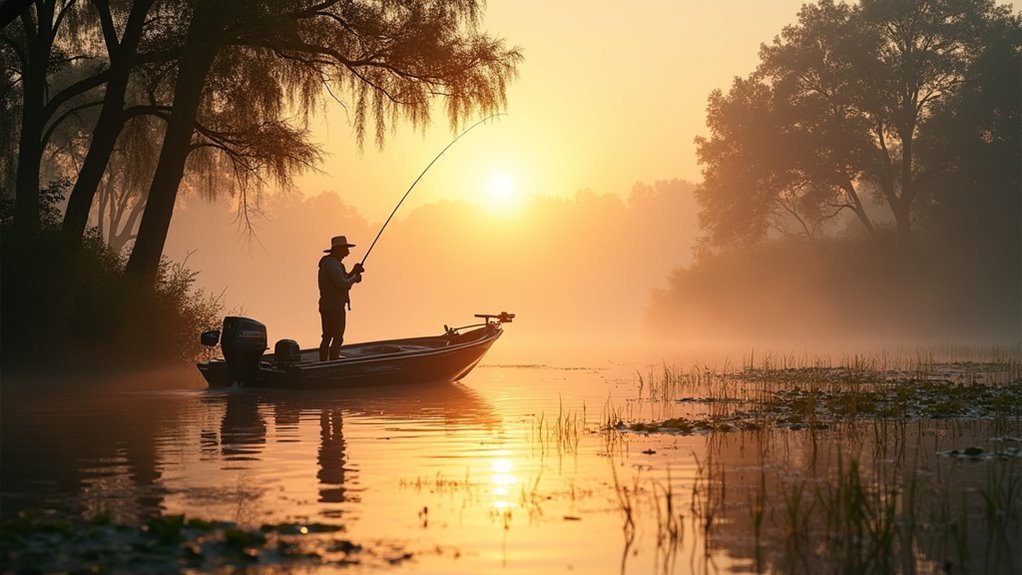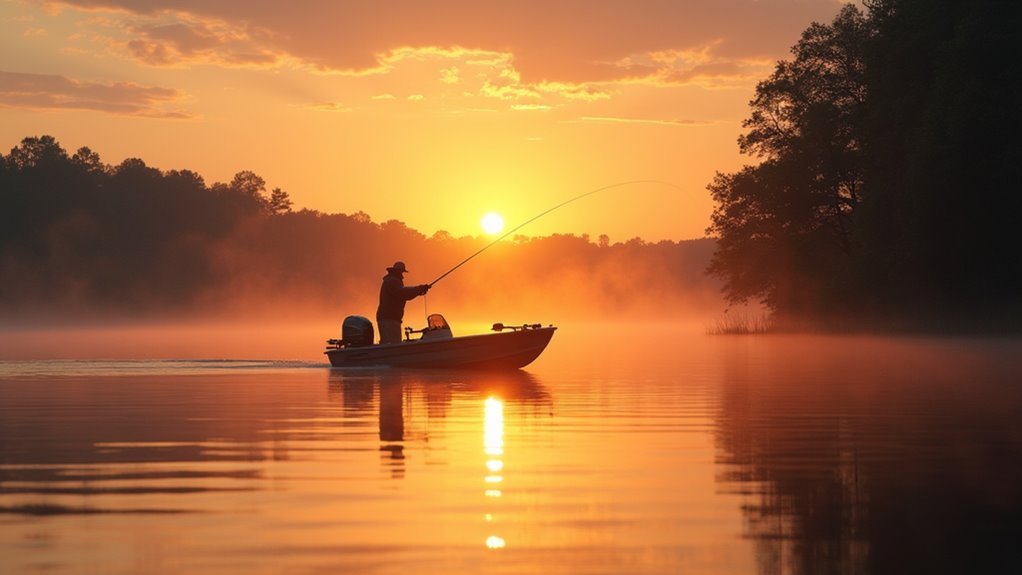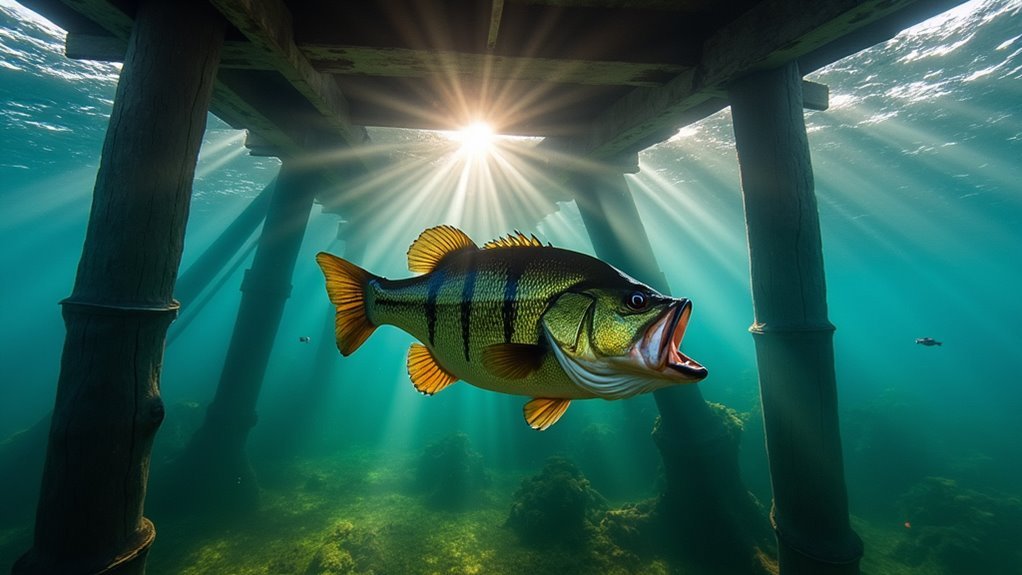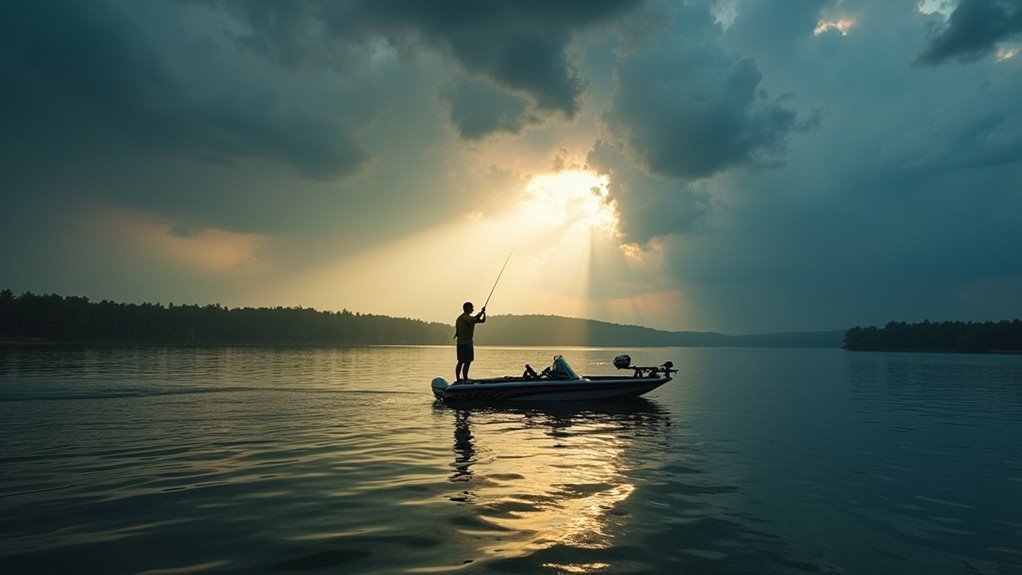We can still catch bass in summer heat—we just need to adjust our strategy. Focus on fishing during dawn and dusk when bass are most active, and target deeper drop-offs (15-25 ft) or shaded docks during midday. Slow down your presentations, downsize your lures, and watch for barometric pressure changes between 29.70-30.40 in Hg. The big ones aren’t inactive; they’re just waiting for the right approach in thermal refuges.
The Summer Behavior of Bass: Myths vs. Reality

While many anglers believe all bass become inactive during the summer heat, the reality is far more nuanced than this common myth suggests. We’ve found that water temperature truly dictates bass behavior, not just the calendar.
Large bass do slow down when temps climb above 85 degrees, but they don’t completely shut down. They’re simply relocating to more comfortable zones. Meanwhile, smaller bass often remain active even in warmer water.
We’ve caught plenty of lunkers in July by targeting deeper drop-offs and shaded areas early morning. The key is understanding that bass adjust their patterns rather than disappearing entirely. They’re still hungry—just more selective about when and where they feed.
Prime Fishing Hours for Hot Weather Success

Timing becomes everything when thermometers climb into the 90s during summer fishing. We’ve learned through countless sweltering days on the water that bass follow predictable patterns when it’s hot.
Dawn and dusk are your golden windows – those first two hours after sunrise and last two before sunset. We’ve caught our biggest summer bass at 5:30 AM when the water’s still cool from the night.
During midday heat, most bass retreat to deeper, cooler waters near drop-offs. If you must fish midday, target shaded areas under docks or thick vegetation where oxygen levels remain higher. Additionally, understanding trolling motor positioning can help you navigate to these prime spots more efficiently.
Locating Bass in Thermal Refuges

As summer temperatures soar, bass seek out specific thermal sanctuaries that can make or break your fishing day. We’ve found bass consistently retreating to cooler water pockets when the mercury rises. They’re not just hiding—they’re strategically positioning themselves for comfort and feeding opportunities.
| Thermal Refuge | Depth Range | Best Lures |
|---|---|---|
| Deep Points | 15-25 ft | Jigs, Worms |
| Creek Channels | 12-20 ft | Crankbaits |
| Shaded Docks | 5-10 ft | Soft Plastics |
Look for thermoclines where warm and cool water meet. We once doubled our catch by dropping just five feet deeper during a scorching July afternoon. These comfort zones become bass magnets!
Tactical Approaches for Sluggish Summer Bass

Even during the hottest summer days, sluggish bass can be coaxed into striking with the right tactical approach. We’ve found that slowing down presentations dramatically improves success when bass are feeling the heat. Instead of aggressive retrieves, try finesse tactics that give fish time to react.
- Downsize your lures – smaller profiles require less energy for bass to pursue
- Work the shadows – fish during low-light periods when bass move shallow to feed
- Extend your pauses – let soft plastics sit motionless for 10-15 seconds between subtle movements
Weather Systems and Pressure Changes: Timing Your Trip

Looking beyond your tackle selection and fishing spots, understanding weather patterns will dramatically increase your summer bass fishing success. We’ve learned to watch barometric pressure closely – when it drops before a storm, bass often go on a feeding frenzy!
The sweet spot lies between 29.70 and 30.40 in Hg. Remember, fish feel pressure changes through their swim bladders. We once caught our limit in 30 minutes when a summer storm was brewing!
Track pressure on your phone’s weather app and time your trips accordingly. Low pressure? Grab your gear! High pressure? Expect sluggish bass requiring slower presentations.
Essential Gear and Budget Considerations for Summer Fishing
When starting your summer bass fishing journey, proper gear selection becomes essential for both your success and enjoyment on the water. We’ve learned over years on the lake that you don’t need to break the bank, but a few quality items make all the difference.
- Invest in a good rod/reel combo ($100-200) that’ll last for many seasons
- Grab essential summer lures: topwater frogs, deep-diving crankbaits, and plastic worms
- Don’t forget sun protection gear – quality hat, UV shirt, and polarized sunglasses
Frequently Asked Questions
Does Bass Fishing Require a Special License for Summer Months?
We don’t need a special license for summer bass fishing. Regular fishing licenses apply year-round, though regulations may vary by state. Always check local requirements before heading out.
How Do Lure Colors Affect Bass Behavior in Clear Versus Murky Water?
In clear water, we choose bright, natural colors; in murky water, we select dark, vibrant options. Bass see lures differently based on visibility—they’ll strike reflective baits in sunlight and noisy colors in stained conditions.
Can Artificial Intelligence Help Predict Optimal Bass Fishing Locations?
Yes, AI can help us predict bass locations by analyzing water temperatures, barometric pressure, seasonal patterns, and underwater structures—giving us data-driven insights beyond traditional fishing knowledge.
Are Night Fishing Techniques Different From Daytime Approaches for Summer Bass?
Yes, night fishing techniques differ greatly. We’ll need slower retrieves, louder lures, and darker colors at night. During summer days, we focus on shaded areas and deeper waters instead.
How Do Catch-And-Release Practices Differ in Summer’s Extreme Temperatures?
We need to handle summer catch-and-release differently. We’ll minimize air exposure, use wet hands, avoid exhausting fish, and release them quickly in cooler water to protect their stressed systems.
Conclusion
We’ve walked through the sweltering days together, and now you’re armed with the tools to turn those dog days into trophy days. Just last August, we were battling 95-degree heat when a massive thunderstorm rolled in. As pressure dropped, we landed three 6-pounders in twenty minutes! Summer success isn’t accidental—it’s about understanding bass behavior, timing, and location. Now get out there and make your own hot-weather memories!